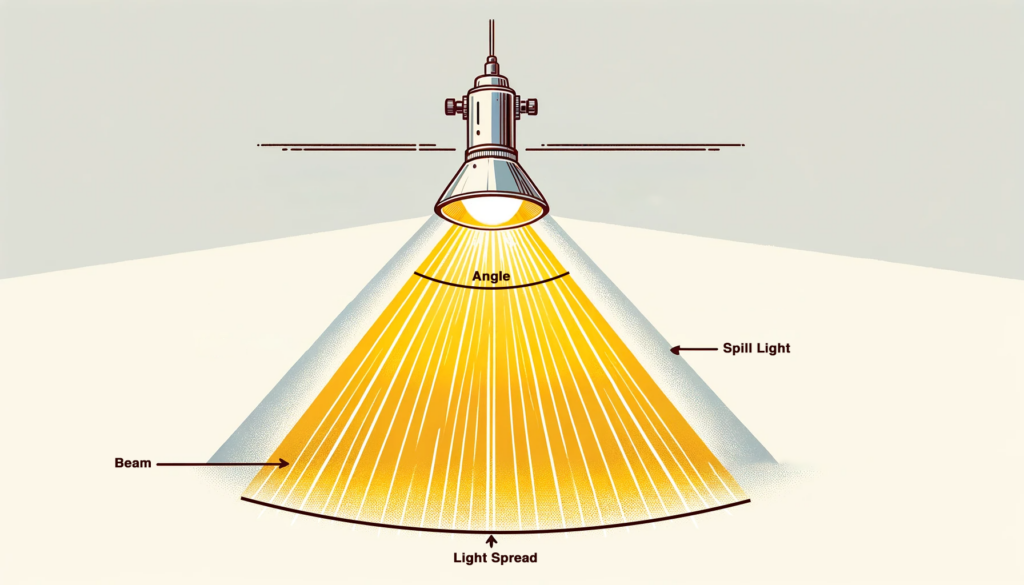Lighting Beam Angle & Spread Calculator December 17, 2023 – Posted in: General Info, Lighting Information

Simple Beam Angle Calculator
Three Value Beam Angle Calculator
To find out the lumens needed for your space, check out our LED lighting calculator.
Table of Contents
Finding the perfect lighting for your space can be tricky, especially when it comes to understanding beam angles. The Lighting Beam Angle Calculator is a vital tool that simplifies this task.
This article will walk you through using this calculator to efficiently determine the ideal beam angle for your needs.
Key Points
- This Lighting Beam Angle Calculator helps you find out how wide light spreads from a bulb or light source.
- You can use the calculator by entering two known values like throw distance (distance from light source) and beam angle, and it will tell you the light spread.
- The correct beam angle is important because it affects how much area a light covers.
- Accurate lighting plans help ensure every part of your space gets enough light.
Understanding the Beam Angle Calculator

A Beam Angle Calculator helps you figure out how wide the light from a bulb will spread on a wall or stage. It tells you the angle of your light beam, so you know how much space the light will cover.
This is useful because different lights have different angles that make them better for certain jobs. For example, a tight beam is good for pointing at something specific, like artwork or lighting a retail product.
A wider beam works well to light up a big area, a flood light is a good example. It also reduces the amount of hard light.
The calculator takes in numbers like the distance between the light and beam angle value and gives back details about the the light’s spread. With this info, lighting experts can pick just the right lights to create their desired effect whether they’re lighting up a room or setting up spotlights on stage.
How to Use the Beam Angle Calculator
Utilizing the Beam Angle Calculator simplifies the process of determining optimal lighting conditions by translating complex measurements into actionable data. Enter known values to quickly ascertain beam width, intensity, and coverage area, enhancing accuracy in any lighting project’s planning stage.
Image Size, Throw Distance & Beam Angle Calculation
Understanding how light spreads is key for lighting pros. Our Beam Angle Calculator helps with this.
- Choose two known values you have, like the image size (light projected on the surface) or the throw distance (distance from the light).
- Enter these numbers in the calculator. You can use feet or meters (the results are accurate no mater the measuring units).
- Remember, the beam angle should be in degrees.
- Click the “calculate” button for the value you need to find out.
- Have a spot size but need to know how far to place your light? Input the spot size and desired beam angle.
- Know where your light goes but not sure about the spread? Enter throw distance and beam angle.
LED Light Beam Angle Formula
Angle = 2* Tan-1 [Beam Spread / Light Distance]
This is the formula used to determine beam angle for light sources.
Light Beam Spread Table
| Degree of Light | At 5 Feet | At 10 Feet | At 15 Feet | At 20 Feet |
| 10° | 0.9 feet | 1.8 feet | 2.7 feet | 3.6 feet |
| 15° | 1.35 feet | 2.7 feet | 4.05 feet | 5.4 feet |
| 20° | 1.8 feet | 3.6 feet | 5.4 feet | 7.2 feet |
| 25° | 2.25 feet | 4.5 feet | 6.75 feet | 9 feet |
| 40° | 3.6 feet | 7.2 feet | 10.8 feet | 14.4 feet |
| 45° | 4.05 feet | 8.1 feet | 12.15 feet | 16.2 feet |
| 60° | 5.4 feet | 10.8 feet | 16.2 feet | 21.6 feet |
| 90° | 8.1 feet | 16.2 feet | 24.3 feet | 32.4 feet |
| 120° | 10.8 feet | 21.6 feet | 32.4 feet | 43.2 feet |
The Significance of Beam Angle in Lighting

The beam angle in lighting is very important. It tells you how light spreads from the source to the area it lights up. Think of a flashlight when you adjust its focus; a narrow beam travels far but lights up only a small spot, while a wide beam covers more space but doesn’t go as far.
In rooms, different tasks need different kinds of light spread. For reading or working on something small, you’d want a more narrow beam to focus on one spot.
For lighting big spaces like stores or stages, wider beams help cover more ground with fewer lights. This means you can use less energy and save money because each light does more work.
Also, if you throw light at least a certain distance away with the right lens tube or fitting, it can make products look better in shops or actors stand out on stage. The key is finding that sweet balance between too much and not enough light for your needs.
Beam Spread & NEMA Types Table
| Beam Spread (°) | NEMA Type | Description |
| 10° – 18° | 1 | Very Narrow |
| > 18° – 29° | 2 | Narrow |
| > 29° – 46° | 3 | Medium Narrow |
| > 46° – 70° | 4 | Medium |
| > 70° – 100° | 5 | Medium Wide |
| > 100° – 130° | 6 | Wide |
| > 130°+ | 7 | Very Wide |
I have been the project manager for Modern.Place since early 2016, spending three of those years working overseas on the manufacturing & procurement side of the LED lighting industry. Constantly learning and passing on knowledge to others while excited for what the lighting industry will involve into next.

